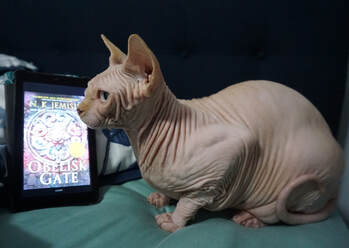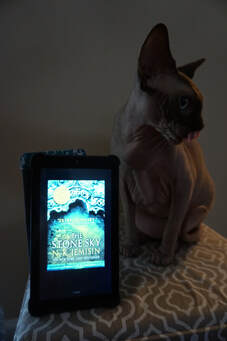|
Wilbur and The Fifth Season (book 1) (left), Wilbur and The Obelisk Gate (book 2) (top right), Clue and The Stone Sky (book 3) (bottom right) photos by Kate Ota 2021 I recently finished The Broken Earth trilogy by N.K. Jemisin which consists of The Fifth Season, The Obelisk Gate, and the Stone Sky. They came out in 2015, ’16, and ’17 respectively. It’s an adult series that is either fantasy or science fantasy, depending on how you look at it.
The series takes place in a world called the Stillness. It’s debatable if this is a crazy far future earth or an alternative, similar planet. The main character is Essun, an orogene. Orogenes are kind of like Earth benders from Avatar: The Last Airbender, but with a few more specifics happening. Orogene work requires energy, so such a person could freeze those around them or steal that energy from, say, an earthquake. They are also highly disliked (ie murdered in public) by the rest of the world, but they come in handy when a Season comes. A Season is when there’s basically an apocalyptic level event such as powerful earthquakes and volcanic eruptions. The plot begins when Essun returns home from work one day to find her orogene son murdered by her (non-orogene) husband, and both her husband and orogrene daughter have disappeared. Then, a Season begins. Her goal is to find her daughter before her husband hurts the innocent girl, but that’s a hell of a task at the end of the world. There’s so much to love about this series, and obviously many people agree. Each book in the series won the Hugo Award (one of the biggest awards in SFF) for Best Book—she’s the first author to ever do that three-peat (in row!) with a series. The Stone Sky also won the Locus and Nebula awards, and both of the first two books in the series were nominated for those awards as well. Going into this series, my expectations were sky high. And you know what? I struggled to get into it. Chapter one was an info dump. One POV was second person (which I really hate). I wasn’t sure I was going to like this series that everyone gushed about. Lucky for me, I have a lengthy, boring commute so I kept reading. It took about halfway through The Fifth Season (book 1) for me to really get in the groove of the story. After that, I bought the second and third book and devoured the series. I recommend this series to adults who grew up loving Avatar: The Last Airbender, fans of magic that’s on the harder side (ie it’s explained and has some logic vs soft, which is very mysterious), and readers who want a (badass) mother as the MC. It is also great for writers looking for an example of deep world building. It’s not for anyone who doesn’t like high fantasy or cannot handle info dumps ever. If you can press through the first chapter and have faith, you’ll be fine. It may also not be for anyone who may have painful memories triggered by violent child loss, child abuse, or gaslighting. Have you read this series too? What other books/series by N.K. Jemisin do you recommend? Have you tried her Master Class? Let’s discuss in the comments!
0 Comments
I painted this wall during a mini-reno on my house. Why it's included will make sense by the end of the post. Photo by Kate Ota 2020 First drafts are often joked about and called things like dumpster fires or garbage drafts. They’re a way of getting ideas out of the writer’s head and onto the page. After all, you can’t edit something that doesn’t exist. First drafts will vary widely based on your writing methods. Plotters will have fewer problems than pantsers (usually), and some people would rather get it right on the first try than just get it down. However, with NaNoWriMo on the horizon, and many people about to write as many words as fast as they can, I thought I’d write about how I take problems spotted in the first draft and utilize them later.
Info Dumps A classic first draft problem, info dumps tell your reader all about the world or the character in one giant section. Not only is telling (vs showing) a potential issue, but info dumps ruin any tension that’s been built and slow the pace. Readers may end up skimming instead of absorbing the information. When you recognize an info dump as you edit, copy/paste it into another document where you keep your notes about the book (worldbuilding, names, etc.). I use Scrivener, so I have a whole folder where I keep this type of stuff. You can then bring back little chunks of info as they become relevant. I like to highlight sentences whose information I’ve added back, so I don’t accidentally repeat myself. Info dumps help you keep track of your world and get you into the mindset, so if you end up taking a break, you can read the info dump to get back into the manuscript. Dropping Characters Have you ever started a book with a cast of characters, but by the end you realize you haven’t mentioned one guy since chapter 4? Oops. It happens all the time. This means that character wasn’t as important as you initially thought. Maybe they aren’t needed at all, and you can take this mistake as a sign you should delete them all together. However, if they matter up front but clearly not later, you can also get rid of them in a way that adds to the story, such as acting as a red herring or increasing tension. Plot Holes Much like pot holes, plot holes make for a bumpy ride in a book. You should try to fill as many as you spot in your edits. However, rather than just filling a hole with the first thing that comes to mind, or the easiest thing to write, take the opportunity to dig a little deeper and see how you can enrich your world, characters, or plot while also filling the hole. It’s like those home renovation shows where they discover bad pipes and they say, “we could just replace the pipes in this bathroom, but eventually the whole house will need to have it redone, and if we do that, it means tearing out all that ugly paneling to get to the pipes behind it.” The wise choice is to rip out the paneling and replace all the pipes, if they have the budget. Since enriching your writing doesn’t cost money, go ahead and rip out the paneling. And the shag carpet, while you’re at it. Off Balance Scenes Some scenes will have too much narration, others will have too much dialogue. This is something you’ll want to balance out, but worry not. This mistake has actually highlighted for you what matters in that scene. Is it all about the dialogue? Then the narration you add in the next draft should be focused on the characters reacting to the dialogue and be less about stage direction. Is it all about narration? Then the dialogue you add shouldn’t be distracting from that and should instead voice the most important internal realizations. Underwriting Perhaps your first draft clocked in at about 60% of the expected word count for your age group and genre. This tells you that something is missing; characters, sub plots, setting or other descriptions, internal narration, etc. It will vary for each writer, but once you notice a pattern in where you skimp, you’ll know what needs to be added. For example, my early drafts lack emotions and reactions, so now I automatically put that in my editing to-do list. It may take more than one book to recognize where you could use more words, but once you know your first draft skinny points, you won’t even need to look to know they’re there. These can then become strengths of your next draft, since you’ll be putting conscious effort into adding these items. Overwriting The opposite of the last problem, if you overshoot your genre and age group’s expected word count, you’ll need to do a little cutting. Ideally, you won’t just delete, but keep removed scenes/paragraphs/sentences in another file for later. You can always come back to these and bring back little pieces to supplement the next draft. It’s easier to squirrel a scene away than it is to delete it, and you may find this strategy makes it emotionally easier to cut words. Identifying what to cut is harder, but if you compare your story’s beats to an established beat sheet (ex Save the Cat) you may be able to identify plot elements that take longer than expected and start hunting for what to cut there. The main benefit of overwriting is that it’s faster to cut than add words. Let's return to my home reno example from earlier. Basically, in a first draft you’re establishing what’s important. That’s setting the blueprint and foundation of the house. Building up the studs and deciding where walls go. First drafts are asking how big is the kitchen, how many beds and baths, is there a basement or a second floor. You don’t need to worry about which poster is going to hand above your desk in your home office. Sure, you can buy one if you see it and have it ready to hang, but the focus is going to be on bigger stuff first, by necessity. Yes, a home reno is messy with painter’s tape and loose nails and dust on everything. However, that’s because it’s not the final step yet. So don’t think of your first draft as garbage, think of it as the start of building a house. How do your first drafts go? Are you a plotter or a panster? Do you over or under write? Let's discuss in the comments! |
Archives
April 2024
Categories
All
|





 RSS Feed
RSS Feed